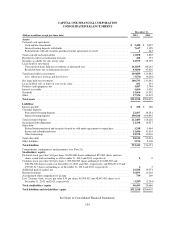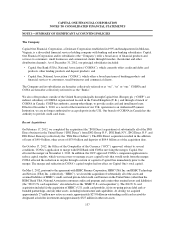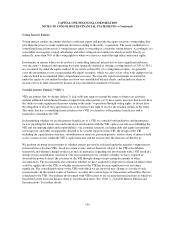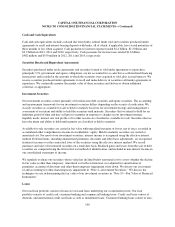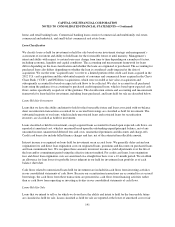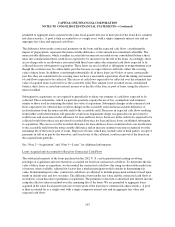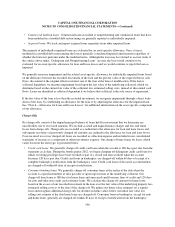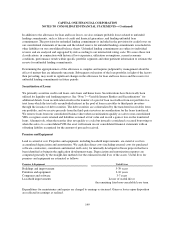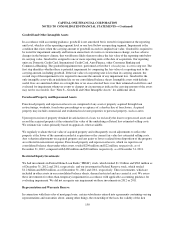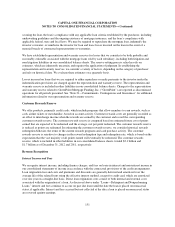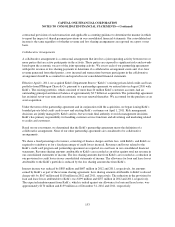Capital One 2012 Annual Report Download - page 163
Download and view the complete annual report
Please find page 163 of the 2012 Capital One annual report below. You can navigate through the pages in the report by either clicking on the pages listed below, or by using the keyword search tool below to find specific information within the annual report.CAPITAL ONE FINANCIAL CORPORATION
NOTES TO CONSOLIDATED FINANCIAL STATEMENTS—(Continued)
Subsequent to acquisition, it is necessary to record an allowance for loan and lease losses, through the provision
for credit losses to properly recognize an estimate of incurred losses on the existing principal balances as of each
reporting date. The allowance for loan and lease losses is calculated using the same methodology utilized for
determining the allowance for our existing credit card portfolio prior to the 2012 U.S. card acquisition, as
described below under “Allowance for Loan and Lease Losses”.
Loan Modifications and Restructurings
As part of our loss mitigation efforts, we may make loan modifications that are intended to minimize the
economic loss and to avoid the need for foreclosure or repossession of collateral. We may provide short-term
(three to twelve months) or long-term (greater than twelve months) modifications to a borrower experiencing
financial difficulty to improve long-term collectability of the loan. Our modifications typically include a
reduction in the borrower’s initial monthly or quarterly principal and interest payment through an extension of
the loan term, a reduction in the interest rate, or a combination of both. For credit card loan agreements, such
modifications may include canceling the customer’s available line of credit on the credit card, reducing the
interest rate on the card, and placing the customer on a fixed payment plan not exceeding 60 months. These
modifications may result in our receiving the full amount due, or certain installments due, under the modified
loan over a period of time that is longer than the period of time originally provided for under the original loan. In
some cases, we may curtail the amount of principal owed by the borrower.
A loan modification in which a concession is granted to a borrower experiencing financial difficulty is accounted
for and reported as a troubled debt restructuring (“TDR”). We describe our accounting for and measurement of
impairment on restructured loans below under “Impaired Loans.” See “Note 5—Loans” for additional
information on our loan modifications and restructurings.
Delinquent and Nonperforming Loans
The entire balance of a loan is considered contractually delinquent if the minimum required payment is not
received by the first statement cycle date equal to or following the due date specified on the customer’s billing
statement. Delinquency is reported on loans that are 30 or more days past due. Interest and fees continue to
accrue on past due loans until the date the loan is placed on nonaccrual status, if applicable. We generally place
loans on nonaccrual status when we believe the collectability of interest and principal is not reasonably assured.
Nonperforming loans generally include loans that have been placed on nonaccrual status and certain restructured
loans whose contractual terms have been restructured in a manner that grants a concession to a borrower
experiencing financial difficulty. We do not report loans accounted for under the fair value option or loans held
for sale as nonperforming.
Our policies for classifying loans as nonperforming, by loan category, are as follows:
•Credit card loans: As permitted by regulatory guidance issued by the Federal Financial Institutions
Examination Council (“FFIEC”), our policy is generally to exempt credit card loans from being classified as
nonperforming as these loans are generally charged off in the period the account becomes 180 days past
due. Consistent with industry conventions, we generally continue to accrue interest and fees on delinquent
credit card loans until the loans are charged-off. When we do not expect full payment of billed finance
charges and fees, we reduce the balance of the credit card account by the estimated uncollectible portion of
any billed finance charges and fees and exclude this amount from revenue. During the fourth quarter 2012,
we began classifying credit card loans issued in the U.K. as nonperforming when the account becomes
either 90 or 120 days past due.
144


